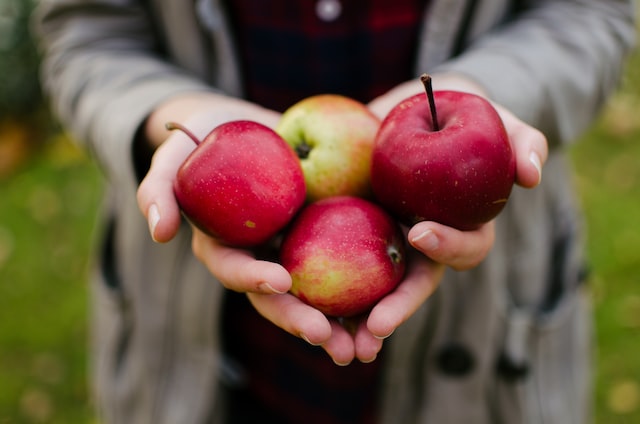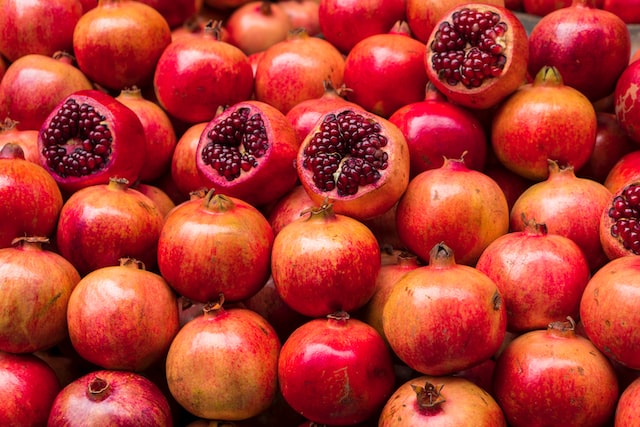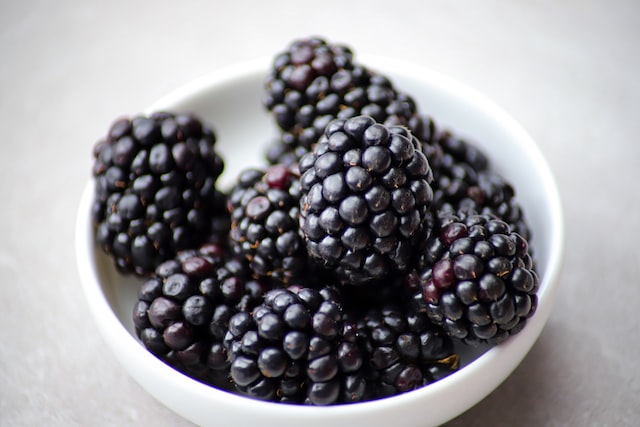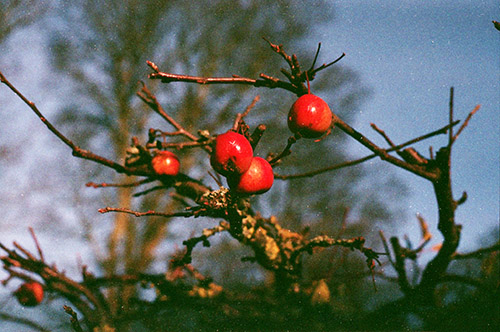Fruit is an important part of our world, whether it’s through our diet, or the many proverbs attached to it. A variation on “An apple a day keeps the doctor away” is “Eat an apple going to bed, make the doctor beg his bread” (Binney 2018: 46). And look how many sayings involve rotten apples.
It’s hardly surprising, then, that fruit would also appear in folklore and mythology. In some cases, it represents a whole concept – like apples standing in for gravity thanks to Isaac Newton, and taking on mythic proportions as a result. Elsewhere, they become an ingredient for witchcraft – either to ward off witches, or to do nefarious deeds.
In the case of some of these fruits, the rest of the plant also has folklore attached. For example, there are remedies involving bramble branches, or apple bark. I’ve chosen to focus solely on the fruit for this article in the interests of length. That said, I’ll no doubt revisit them where necessary for their wider folklore at some point!
So let’s investigate the folklore attached to these particular fruits found in the wider British Isles!
Oranges
According to Ruth Binney, witches used oranges to represent a victim’s heart until the 1880s. The general idea involved writing their name on a slip of paper, pinning it to the fruit, and leaving it in the chimney until they died (2018: 83).
Oranges first arrived in England in the 1300s, although people couldn’t grow them here until the 1700s thanks to our climate. In the 18th century, wealthy landowners built orangeries to grow tropical plants, including oranges. They’d become a staple ingredient by the 1800s (the oranges, not the landowners).
Oranges and lemons are both famous from the nursery rhyme appearing alongside the bells of St Clement’s. That might refer either to St Clement Danes, the church opposite the Royal Courts of Justice on the Strand, or St Clement Eastcheap. St Clement Danes began a custom of decorating the church with oranges and lemons in 1920 to mark the restoration of the church bells. Children from a nearby school attend a service, and are given fruit as they leave (Simpson 2003: 268).

No one truly knows what the rhyme means, if anything. This is something you find a lot with nursery rhymes: people love to read things into them, regardless of fact. Still, people have tried to claim it’s about Henry VIII’s wives, child sacrifice, a condemned criminal taking a tour of the churches, and even a woman losing her virginity. The problem is that none of the theories really explain the rhyme in a satisfactory way.
The first printed version appeared in 1744 in a different format, and there’s no reference to chopping anything. Remember both churches linked with oranges and lemons were near wharves where people unloaded citrus fruits. While other churches were nearer, Clement’s makes a nice rhyme with lemons. If anything, the rhyme being used to list churches makes just as much sense as any of the other interpretations.
Apples in Mythology
In Norse mythology, Idun (IH-dune), the goddess of youth, looked after golden apples that conferred eternal youth. Loki kidnapped her to save his own skin, handing her over to the giant Thiazi. Without the apples, the gods grew old. They discovered Loki’s part in the problem and sent him to Jotunheim to rescue Idun. That said, apples didn’t reach Scandinavia until the late Middle Ages, so no one entirely knows what fruit Idun actually grew (Turville-Petre 1964: 186).
Dionysus apparently created the apple to assure Aphrodite’s fertility (Binney 2018: 45). This is rather less famous than the golden apples growing on the tree in the Garden of the Hesperides. Gaia gave these to Zeus and Hera as a wedding present.
It was one of these apples that Eris, goddess of discord, inscribed with the words ‘For the fairest’, and then tossed among the gods at the wedding feast of Peleus and Thetis. Aphrodite, Athena, and Hera all claimed the apple, and Zeus refused to choose between them. He instead abdicated the responsibility to Paris, prince of Troy.

Each of the goddesses offered a bribe, and Paris eventually chose Helen, the most beautiful woman on earth. His quest to abduct her led to the Trojan War. All for a golden apple.
Apple Remedies
There was also a wart removal remedy involving apples. You would cut an apple in half, and rub the pieces on the wart. Then you’d put the apple back together, bind it with string, and bury it. The general idea behind it was that the warts would disappear as the apple rotted (Binney 2018: 120).
Surprisingly, this remedy lives on in the modern ‘remedy’ of soaking warts in apple cider vinegar. There’s no scientific evidence to say it actually works, though anecdotally, some people report success with it.
If the sun shrines through an apple tree on Christmas Day, it means you’ll have a good harvest next year (Inkwright 2019: 35). If an apple remained on a tree after winter, it meant a death was imminent (Binney 2018: 45). Meanwhile, if the apple harvest was good, people believed it was also a good year for women to bear twins (Opie 2005: 3).
Divination by Apple
Apples are probably most associated with divination at Halloween. You could also peel an apple in an unbroken strip and throw it over your shoulder, and it would form the initial of your next lover. An alternative to this sees the woman hang the unbroken peel on a nail behind a door. The person she would marry would have the same initials as the first man who entered the house (Opie 2005: 3).
If you had several lovers to choose from, you would assign a different person to a different apple pip. Then you’d throw them into the fire, saying ‘If you love me, pop and fly/If you hate me, lay and die’. This would tell you which lovers to keep (Binney 2018: 132).

Don’t have any lovers and wondering where one might come from? Squeeze an apple pip between your finger and thumb. Say ‘Kernel come kernel, hop over my thumb, and tell me which way my true love will come, East, west, north, or south, Kernel jump into my true love’s mouth’. Then shoot the pip out from between your finger and thumb (Binney 2018: 132).
You could also press apple pips to your cheek or forehead. Whichever ones stuck meant those people loved you, while the ones that fell off had no regard for you (Opie 2005: 4).
A slightly easier option is to recite the alphabet while you twist off an apple stalk. Note the letter you reach when the stalk comes off. That’s the initial your lover will have (Binney 2018: 132). Want to know the initial of his surname? Recite the alphabet again while tapping the apple with the now-removed stalk. The letter you reach with the stalk pierces the skin will be the initial of his surname (Opie 2005: 4).
Pomegranates
This fruit is perhaps most famous from its appearance in the legend of Persephone and Hades, in which Hades gave Persephone a pomegranate to eat after abducting her to the underworld. The number of seeds she ate dictated the number of months she was condemned to spend in the underworld every year. Her absence every year while she’s Queen of the Underworld apparently explains autumn and winter, while her mother Demeter mourns her.

This perhaps explains the association between pomegranates and fertility, although that could also be due to its many seeds. People would carry the fruit in an effort to ensure fertility (Binney 2018: 64). According to Christina Oakley Harrington, Londoners in the 17th century also carried bits of pomegranates with them to ward off witchcraft (2020: 102). So that might give you a bit of a ‘2 for 1’.
Of course, it’s not the only fruit associated with fertility. People considered figs an aphrodisiac, while brides ate quinces on their wedding night to help ensure they’d easily fall pregnant (Binney 2018: 64).
Blackberries
The most famous folklore associated with blackberries comes in the form of a date. You’re not to eat the fruit after Michaelmas, or 29 September. According to folklore, this was the day on which Lucifer was cast from heaven, and landed in a blackberry patch. He spat on the bramble out of annoyance, and thus the berries should be considered off-limits after the date.
Variations occur, with those in the north saying the Devil passed his cloven hooves over the fruit at Michaelmas. Others said he dragged his tail over them (Opie 2005: 29).

Either way, the fruit isn’t safe for consumption after this point since they start to deteriorate. As ever, folklore provides a way to encourage people to avoid something that will cause harm, even if the reason isn’t the one given.
Some say brambles belong to the Good Neighbours, so you should leave the first blackberries of the season for the fairies (Inkwright 2019: 49). Others in Ireland and Cornwall say that the strawberry is the favourite fruit of fairies, so the first strawberry becomes an offering to the fairies for a good harvest (Inkwright 2019: 145). The berry was unheard of before 1300 in northern Europe, which perhaps explains its relative absence within folklore compared to blackberries.
What do we make of this fruit folklore?
One of the advantages of fruit as a remedy, offering, or magical item is its relative ubiquity. While yes, fruit is seasonal, if you have the right growing conditions, you have a ready supply of the fruit you need.
But a lot of fruit folklore also speaks to the ease with which people could interact with it. Carrying a piece of fruit wouldn’t necessarily raise any eyebrows. Meanwhile, divining with apple pips creates a new use for something we’d normally throw away. It helps to show how much protective or even magical practices were part of the everyday landscape
Do you have any favourite sayings or practices related to fruit?
References
Binney, Ruth (2018), Plant Lore and Legend, Hassocks: Rydon (aff link).
Harrington, Christina Oakley (2020), The Treadwell’s Book of Plant Magic, London: Treadwells Books.
Inkwright, Fez (2019), Folk Magic and Healing: An Unusual History of Everyday Plants, London: Liminal 11 Press (aff link).
Opie, Iona and Moira Tatem (2005), Oxford Dictionary of Superstitions, Oxford: Oxford University Press (affiliate link).
Simpson, Jacqueline and Steve Roud (2003), Oxford Dictionary of English Folklore, Oxford: Oxford University Press (aff link).
Turville-Petre, Gabriel (1964), Myth and Religion of the North: The Religion of Ancient Scandinavia, London: Weidenfeld and Nicolson.
Nutty about folklore and want more?
Add your email below and get these posts in your inbox every week.
You'll also get my 5-step guide to protecting your home using folklore!









Have your say!